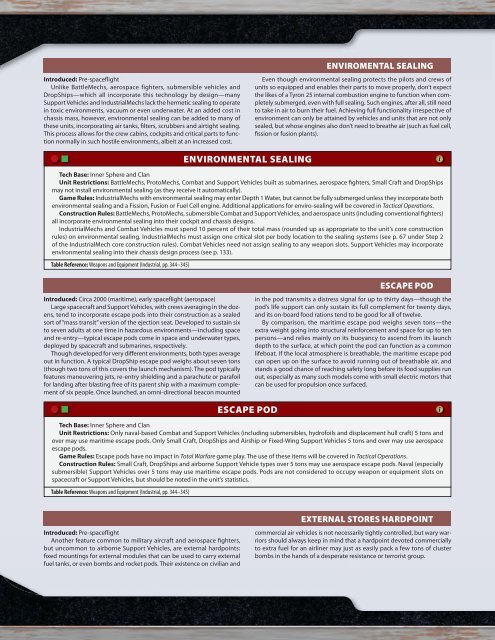the shape of things to come
the shape of things to come
the shape of things to come
You also want an ePaper? Increase the reach of your titles
YUMPU automatically turns print PDFs into web optimized ePapers that Google loves.
Introduced: Pre-spacefl ight<br />
Unlike BattleMechs, aerospace fighters, submersible vehicles and<br />
DropShips—which all incorporate this technology by design—many<br />
Support Vehicles and IndustrialMechs lack <strong>the</strong> hermetic sealing <strong>to</strong> operate<br />
in <strong>to</strong>xic environments, vacuum or even underwater. At an added cost in<br />
chassis mass, however, environmental sealing can be added <strong>to</strong> many <strong>of</strong><br />
<strong>the</strong>se units, incorporating air tanks, fi lters, scrubbers and airtight sealing.<br />
This process allows for <strong>the</strong> crew cabins, cockpits and critical parts <strong>to</strong> function<br />
normally in such hostile environments, albeit at an increased cost.<br />
ENVIROMENTAL SEALING<br />
Even though environmental sealing protects <strong>the</strong> pilots and crews <strong>of</strong><br />
units so equipped and enables <strong>the</strong>ir parts <strong>to</strong> move properly, don’t expect<br />
<strong>the</strong> likes <strong>of</strong> a Tyron 25 internal combustion engine <strong>to</strong> function when completely<br />
submerged, even with full sealing. Such engines, after all, still need<br />
<strong>to</strong> take in air <strong>to</strong> burn <strong>the</strong>ir fuel. Achieving full functionality irrespective <strong>of</strong><br />
environment can only be attained by vehicles and units that are not only<br />
sealed, but whose engines also don’t need <strong>to</strong> brea<strong>the</strong> air (such as fuel cell,<br />
fi ssion or fusion plants).<br />
Tech Base: Inner Sphere and Clan<br />
Unit Restrictions: BattleMechs, Pro<strong>to</strong>Mechs, Combat and Support Vehicles built as submarines, aerospace fi ghters, Small Craft and DropShips<br />
may not install environmental sealing (as <strong>the</strong>y receive it au<strong>to</strong>matically).<br />
Game Rules: IndustrialMechs with environmental sealing may enter Depth 1 Water, but cannot be fully submerged unless <strong>the</strong>y incorporate both<br />
environmental sealing and a Fission, Fusion or Fuel Cell engine. Additional applications for enviro-sealing will be covered in Tactical Operations.<br />
Construction Rules: BattleMechs, Pro<strong>to</strong>Mechs, submersible Combat and Support Vehicles, and aerospace units (including conventional fi ghters)<br />
all incorporate environmental sealing in<strong>to</strong> <strong>the</strong>ir cockpit and chassis designs.<br />
IndustrialMechs and Combat Vehicles must spend 10 percent <strong>of</strong> <strong>the</strong>ir <strong>to</strong>tal mass (rounded up as appropriate <strong>to</strong> <strong>the</strong> unit’s core construction<br />
rules) on environmental sealing. IndustrialMechs must assign one critical slot per body location <strong>to</strong> <strong>the</strong> sealing systems (see p. 67 under Step 2<br />
<strong>of</strong> <strong>the</strong> IndustrialMech core construction rules). Combat Vehicles need not assign sealing <strong>to</strong> any weapon slots. Support Vehicles may incorporate<br />
environmental sealing in<strong>to</strong> <strong>the</strong>ir chassis design process (see p. 133).<br />
Table Reference: Weapons and Equipment (Industrial, pp. 344–345)<br />
Introduced: Circa 2000 (maritime), early spacefl ight (aerospace)<br />
Large spacecraft and Support Vehicles, with crews averaging in <strong>the</strong> dozens,<br />
tend <strong>to</strong> incorporate escape pods in<strong>to</strong> <strong>the</strong>ir construction as a sealed<br />
sort <strong>of</strong> “mass transit” version <strong>of</strong> <strong>the</strong> ejection seat. Developed <strong>to</strong> sustain six<br />
<strong>to</strong> seven adults at one time in hazardous environments—including space<br />
and re-entry—typical escape pods <strong>come</strong> in space and underwater types,<br />
deployed by spacecraft and submarines, respectively.<br />
Though developed for very diff erent environments, both types average<br />
out in function. A typical DropShip escape pod weighs about seven <strong>to</strong>ns<br />
(though two <strong>to</strong>ns <strong>of</strong> this covers <strong>the</strong> launch mechanism). The pod typically<br />
features maneuvering jets, re-entry shielding and a parachute or parafoil<br />
for landing after blasting free <strong>of</strong> its parent ship with a maximum complement<br />
<strong>of</strong> six people. Once launched, an omni-directional beacon mounted<br />
ENVIRONMENTAL SEALING<br />
ESCAPE POD<br />
in <strong>the</strong> pod transmits a distress signal for up <strong>to</strong> thirty days—though <strong>the</strong><br />
pod’s life support can only sustain its full complement for twenty days,<br />
and its on-board food rations tend <strong>to</strong> be good for all <strong>of</strong> twelve.<br />
By comparison, <strong>the</strong> maritime escape pod weighs seven <strong>to</strong>ns—<strong>the</strong><br />
extra weight going in<strong>to</strong> structural reinforcement and space for up <strong>to</strong> ten<br />
persons—and relies mainly on its buoyancy <strong>to</strong> ascend from its launch<br />
depth <strong>to</strong> <strong>the</strong> surface, at which point <strong>the</strong> pod can function as a common<br />
lifeboat. If <strong>the</strong> local atmosphere is breathable, <strong>the</strong> maritime escape pod<br />
can open up on <strong>the</strong> surface <strong>to</strong> avoid running out <strong>of</strong> breathable air, and<br />
stands a good chance <strong>of</strong> reaching safety long before its food supplies run<br />
out, especially as many such models <strong>come</strong> with small electric mo<strong>to</strong>rs that<br />
can be used for propulsion once surfaced.<br />
Tech Base: Inner Sphere and Clan<br />
Unit Restrictions: Only naval-based Combat and Support Vehicles (including submersibles, hydr<strong>of</strong>oils and displacement hull craft) 5 <strong>to</strong>ns and<br />
over may use maritime escape pods. Only Small Craft, DropShips and Airship or Fixed-Wing Support Vehicles 5 <strong>to</strong>ns and over may use aerospace<br />
escape pods.<br />
Game Rules: Escape pods have no impact in Total Warfare game play. The use <strong>of</strong> <strong>the</strong>se items will be covered in Tactical Operations.<br />
Construction Rules: Small Craft, DropShips and airborne Support Vehicle types over 5 <strong>to</strong>ns may use aerospace escape pods. Naval (especially<br />
submersible) Support Vehicles over 5 <strong>to</strong>ns may use maritime escape pods. Pods are not considered <strong>to</strong> occupy weapon or equipment slots on<br />
spacecraft or Support Vehicles, but should be noted in <strong>the</strong> unit’s statistics.<br />
Table Reference: Weapons and Equipment (Industrial, pp. 344–345)<br />
Introduced: Pre-spacefl ight<br />
Ano<strong>the</strong>r feature common <strong>to</strong> military aircraft and aerospace fi ghters,<br />
but uncommon <strong>to</strong> airborne Support Vehicles, are external hardpoints:<br />
fi xed mountings for external modules that can be used <strong>to</strong> carry external<br />
fuel tanks, or even bombs and rocket pods. Their existence on civilian and<br />
ESCAPE POD<br />
EXTERNAL STORES HARDPOINT<br />
commercial air vehicles is not necessarily tightly controlled, but wary warriors<br />
should always keep in mind that a hardpoint devoted commercially<br />
<strong>to</strong> extra fuel for an airliner may just as easily pack a few <strong>to</strong>ns <strong>of</strong> cluster<br />
bombs in <strong>the</strong> hands <strong>of</strong> a desperate resistance or terrorist group.<br />
i<br />
i


